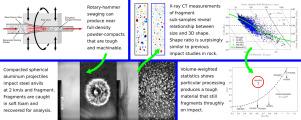Size-dependent fragment shape in high-velocity anvil impact of spherical metal powder-compacts
IF 8.3
1区 材料科学
Q1 MATERIALS SCIENCE, MULTIDISCIPLINARY
引用次数: 0
Abstract
Room-temperature mechanical swaging of metallic powders allows the flexible synthesis of fully consolidated, composite powder compacts that can retain nearly the full strength, toughness, density, and machinability of their bulk parent elements. The swaging process offers the ability to compositionally tailor a material to exploit reactive inter-phase chemistry. Unlike some other cold powder-metallurgy fabrication methods, though, it can produce mechanically competent materials capable of serving in structurally useful applications. By means of fragment soft-catch and recovery, we evaluate the effects of initial powder size and degree of mechanical swaging on the impact fragmentation statistics of pure aluminum powder-swaged projectiles. Here, processing alone induces a wide range of impact fragmentation behavior, generally correlating with the effective toughness of the swaged product. As such, we interrogate the dynamic fragmentation of both brittle and tough metals across this range without varying composition. We observe a clear relationship between fragment size and shape, utilizing this relationship to improve high-throughput optical measurements of volume-weighted fragment size. We find surprisingly similar average fragment shape to previous hypervelocity impact experiments on geological materials, suggesting some common underlying mechanical patterns of fragmentation in the ballistic impact of otherwise disparate materials. Furthermore, post-mortem analysis suggests that the selection of appropriate starting particle size and degree of swaging in rotary-swaged metals provides some distinct and potentially valuable ability to tune dynamic fragmentation, in comparison to that of the wrought metal, while maintaining suitably high quasi-static toughness and ductility for engineering purposes.


求助全文
约1分钟内获得全文
求助全文
来源期刊

Acta Materialia
工程技术-材料科学:综合
CiteScore
16.10
自引率
8.50%
发文量
801
审稿时长
53 days
期刊介绍:
Acta Materialia serves as a platform for publishing full-length, original papers and commissioned overviews that contribute to a profound understanding of the correlation between the processing, structure, and properties of inorganic materials. The journal seeks papers with high impact potential or those that significantly propel the field forward. The scope includes the atomic and molecular arrangements, chemical and electronic structures, and microstructure of materials, focusing on their mechanical or functional behavior across all length scales, including nanostructures.
 求助内容:
求助内容: 应助结果提醒方式:
应助结果提醒方式:


